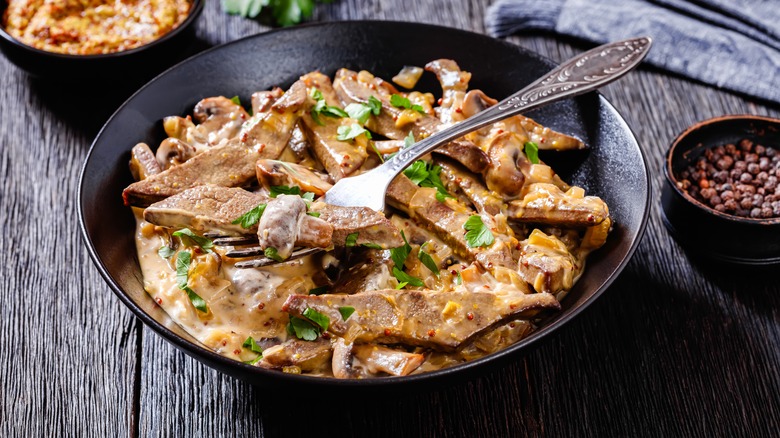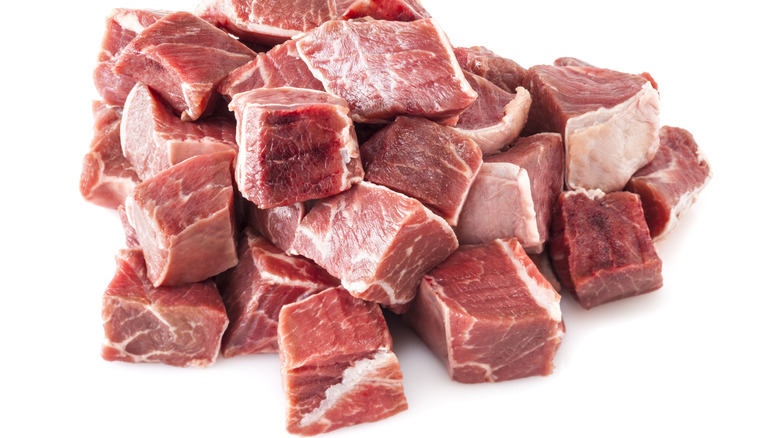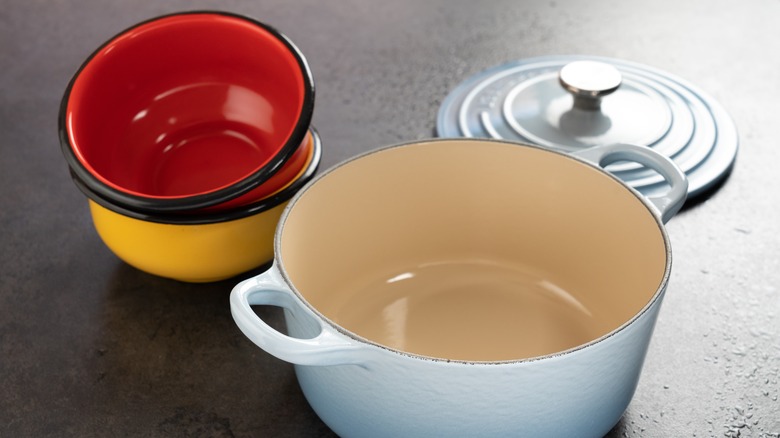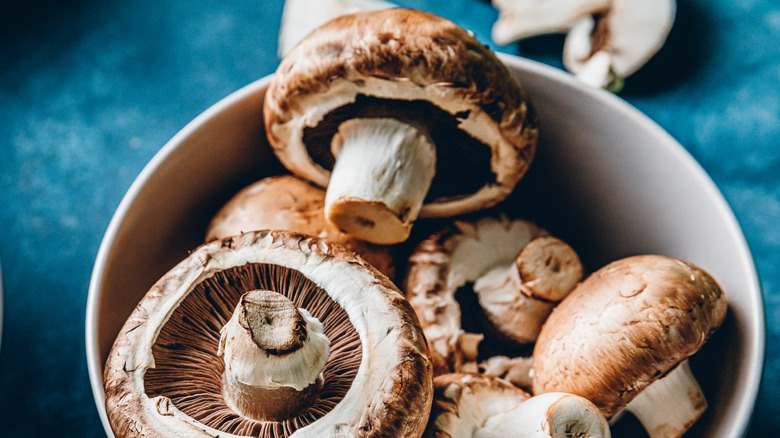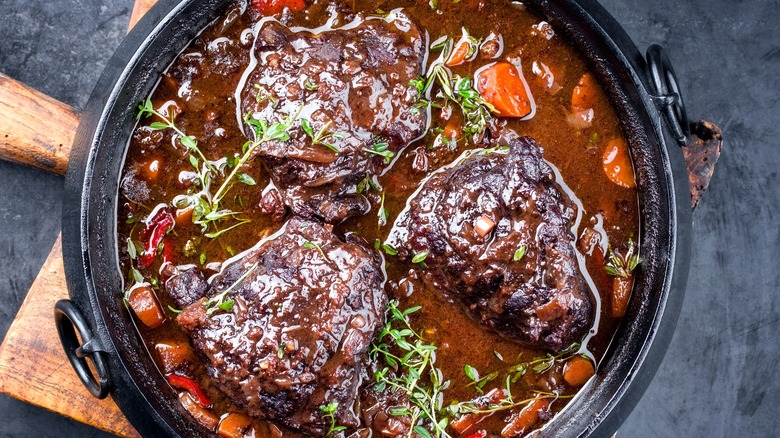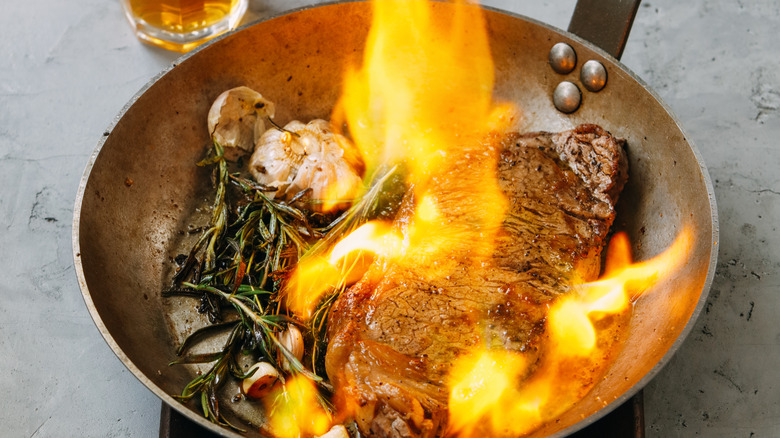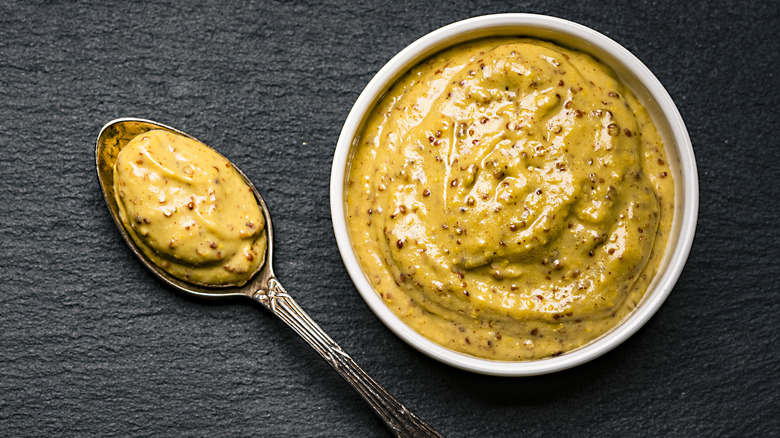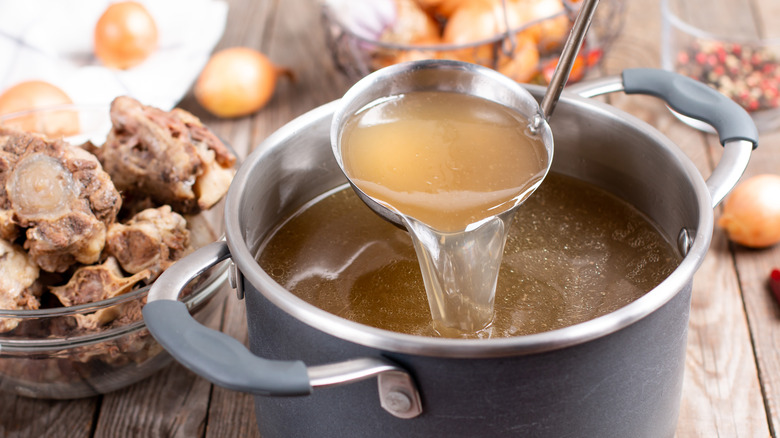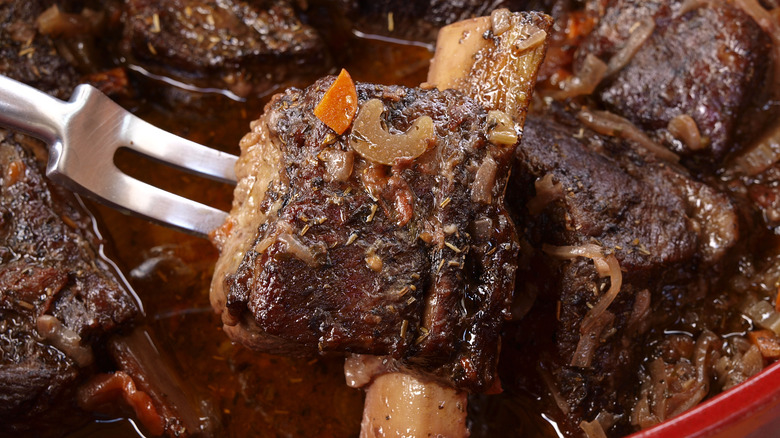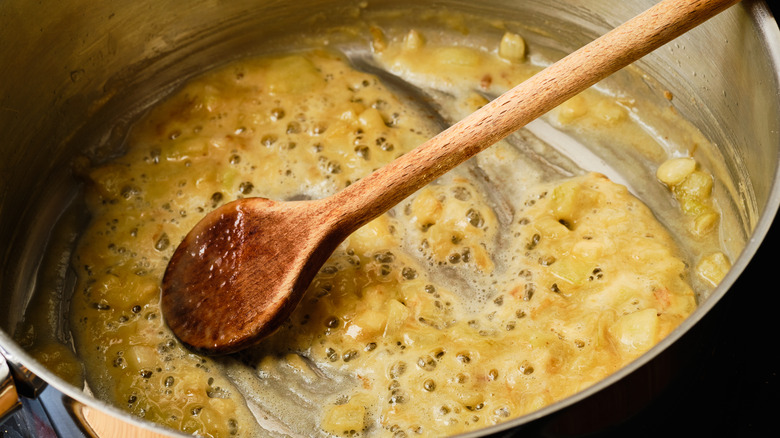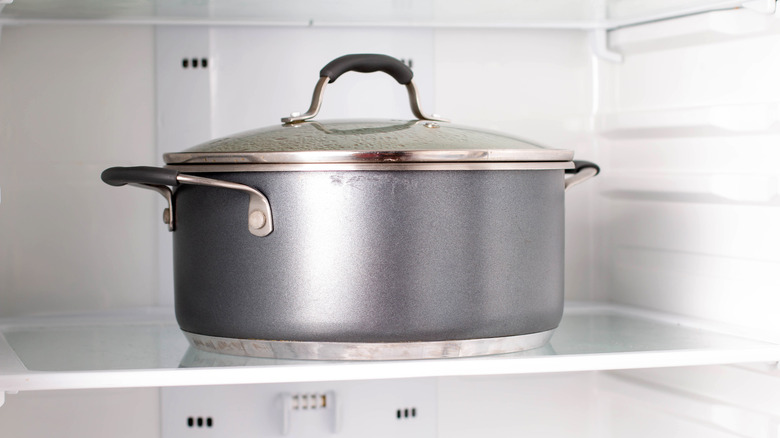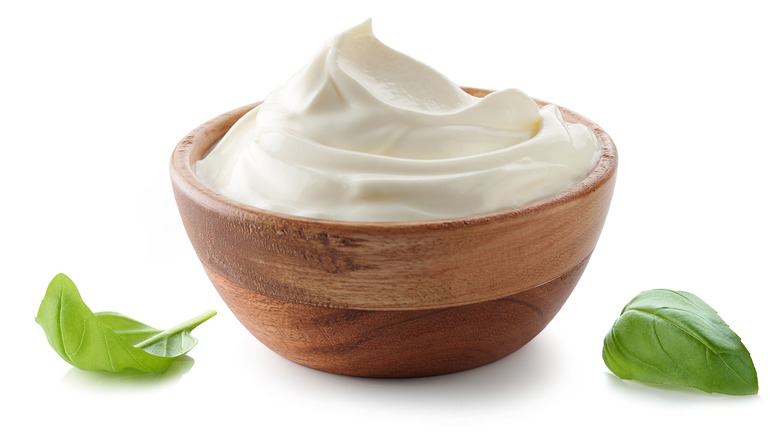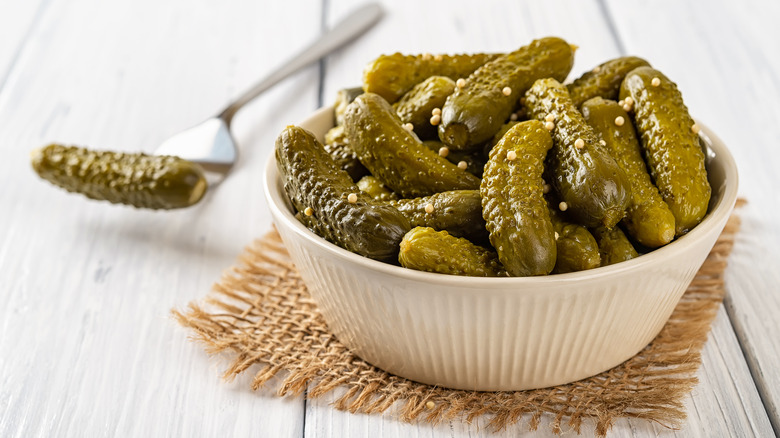12 Tips To Help Master Beef Stroganoff
Beef stroganoff is as misunderstood as its origins. The one thing agreed upon about its backstory is that it is tied to something cooked for, or by, the Stroganoff (Stroganov) family, and its roots are Russian or Ukrainian. The Stroganoff family name is one of the most significant in czarist Russia, dating back to the mid-15th century. Theories vary, but whatever the exact origin is, the dish is both classic and flexible.
Some of the staying power of beef stroganoff comes from its flexibility. You can serve it as a stew, switch the type of beef for a quick sauté, or change from beef to beef liver. Given that, one could safely forgo beef or make a poultry-based version and still have it be considered a stroganoff.
Even though the dish is flexible, sometimes folks take too many liberties with it, and it becomes a mashup of "all things Eastern European," which is a shame because, in its purest form, beef stroganoff is a rich and decadent dish that still appeals to many varying personal tastes. Getting to the essential elements, stroganoff is beef, mushrooms, onions, mustard, and some herbs for flavoring. Treating those ingredients well can return what many consider a working-class dish to something suitable for nobility.
Select the proper cut of beef
We will take the slow-cooked approach of making stroganoff and treat the dish as a stew. Stewing and braising are close cousins, and some cuts of beef are better suited for the task than others. Choosing the proper cut of meat is the first important decision you'll have to make in this process. Because of the long cooking time, the best cuts will have good intramuscular fat and connective tissue. In descending order of preference, chuck, sirloin, short rib, brisket, shank, and tail are all good options. The connective tissue is crucial to adding richness to the dish because as the meat cooks, that tissue releases collagen, making the stew richer and more mouth-coating. A ribeye has good fat and marbling but insufficient connective tissue. Tenderloin lacks in both departments, and those two cuts might be best left for a quick sauté version or left out of the conversation entirely.
After selecting your cut, you'll want to trim any excess fat and cut it into bite-sized cubes. Doing this shortens the cooking time versus cooking the meat whole, and the shortened cooking time allows the pieces to remain whole versus shredding the meat after cooking.
Use the right type of pan
Proper cookware won't make you a good cook, but it will make it easier to cook well. The stroganoff will stew for a few hours, so you'll want a pan that will withstand the lengthy cooking time without scorching your food. You also want a pan that can sear without burning, and a thick-bottomed pan is necessary for that aspect. You'll also want to build a fond (more on that later), so a non-stick pan isn't going to fit the bill.
So what's this magical pan that will do all that? You probably already have it. You don't need a special pan for braising; a Dutch oven will do quite nicely. It will also benefit you if the Dutch oven is oven-proof, but it's not a requirement. If you're short on dedicated time to watch your pot simmer or don't want to hover over the stove, putting the pot in the oven alleviates some of the need for watchfulness. Also helpful, but not required for stovetop cooking, is a lid for your Dutch oven, which minimizes evaporation during the cooking process. If you go the oven route, we highly recommend covering the pot to avoid any exposed meat or veggies browning and to slow evaporation.
Don't forgo the mushrooms
As we've said, there are many variations on the beef stroganoff recipe. We realize that people have varying tastes, but we'd like to make the case for keeping the mushrooms (and onions) in the dish. Stroganoff is about richness, as evidenced not only by the rich ingredients but also by its origins. A dish created by or for Russian nobility had to have some decadence to it. Decadence needn't come in the form of luxury ingredients; the taste and texture can provide that.
Umami is the decadence in this dish. Mushrooms are an excellent ingredient to build umami, lending depth and texture to the broth. Besides, mushrooms and red meat are a natural pairing. The darker the mushroom, the better the fit with beef. You don't even need to get fancy with your mushrooms, though. White button mushrooms are fine. Cremini (baby bella), the same mushrooms as button or portabella (just in different stages of maturity), fit the bill here. Of course, if you want to branch out with your mushrooms, you can. If you choose that route, shiitake, morels, chanterelles, or porcini would serve to level up the dish. If you're mushroom-averse because of their texture, powdered forms of mushrooms are available at many stores, allowing you to build that umami without the unpleasant texture. Just please don't forgo them entirely if you don't have a more compelling reason to do so.
Brown your beef
Building flavor starts with how you treat your beef and other ingredients. Start by patting your cut pieces of meat dry. Removing moisture at this point helps build Maillard browning, making a richer stew. Season your beef generously with kosher or sea salt, and heat your Dutch oven over medium heat for about five minutes. You don't want to work over high heat at this point, as we're trying to avoid scorching. Add a little oil to your Dutch oven, then add your meat, laying it out in a single layer across the bottom of your pan. You might have to work in batches to accomplish this. Turn the beef over as the first side browns, repeating to cover all sides. Remove the meat and add the next round, if necessary.
A brown coating called the fond will form over the bottom of the pot as the meat browns. The fond is as valuable as gold to the flavor and texture of your stew. After all your meat browns, set it aside and add your onions and mushrooms. Season these well with salt, and you'll see some water start to weep from the vegetables. Using the tip of a wooden spoon or silicone spatula, use this liquid to help you scrape the fond from the pan. After the vegetables have released all their water, keep cooking until the liquid evaporates and the vegetables lose their raw crunchiness and taste like cooked onions and mushrooms.
Infuse booze (properly)
Now that you've browned your meat and sweated your vegetables, it's time to add the meat back to the pot. Some juices will release from the meat while you're sweating the vegetables, which is fine; add that to the pot, too. While sweating the vegetables, you'll notice that more fond has developed. It's time to collect that and use it to your advantage.
Recipes vary, some calling for brandy, others for red wine. The older, more traditional, recipes call for brandy, so we'll stick to that, although you don't have to. Before adding the brandy, remove the pot from the burner if you're using a gas stove, as brandy is flammable. Add the brandy, return the Dutch oven to the burner, and again use a spoon or silicone spatula to scrape the fond from the bottom. This point is where many people miss an opportunity to build flavor.
Turn the burner to high until the brandy boils. Let it keep boiling. During this step, water evaporates from the brandy, and you concentrate the brandy's flavor. You get a more intense flavor without the additional liquid, yielding a better stew. When the brandy is almost completely evaporated, with a syrupy consistency in the bottom of the pot, you can move on to adding your cooking liquid.
The right herbs and flavorings make all the difference
Your next step to success is what goes into the stroganoff and how you add those ingredients. Again, there are many recipe variations out there, some calling for spices like paprika or allspice. To keep this in line with the classic idea of beef stroganoff, we'll forgo those, keeping the dish as straightforward as possible.
Thyme is almost always on the ingredient list. It's got a great, earthy flavor that's best activated by cooking it with a little fat. With that in mind, adding the thyme to the pot at the same time as your vegetables allows the essential oils to activate and bloom to their best potential. Mustard is the next non-negotiable ingredient. Unlike thyme, mustard is water- and vinegar-based, so you want to add it to your cooking liquid to avoid drying out and scorching. We already spoke of seasoning the vegetables and meat with salt before cooking, but don't add pepper at that point. Pepper burns at searing temperatures, so don't season your meat with it. Instead, add the pepper to the vegetables, like the thyme, as it also benefits from fat and heat activation. There are two more ingredients that we'll cover in the subsequent steps.
Avoid skimping on the stock
It's time to start the wet cooking part of the stew, which is stroganoff. You can use plain tap water if that's all you have, but stock is a much better option. Stock is another vehicle for adding flavor and richness to the stroganoff, and it's the liquid of choice for many chefs. You can use off-the-shelf grocery store stock, which is more broth than stock. You can also make your own if you have the time and wherewithal to do so. Bone broth is close to real stock, so you can also use that if the urge strikes.
Stock is the end result of simmering bones with carrots, onions, celery, and other aromatics for hours. That long cooking breaks down connective tissue, which is collagen-rich and gives you a feeling of coating your tongue in sauces and stews. If you're seeking the most luxurious version of stroganoff, a rich, homemade stock is the best liquid to cook it in.
Don't undercook it
Now that you've added your stock to the pot, it's time to let the stew simmer, either on the stovetop or by bringing it to a simmer and transferring it to a 300 F oven. Simmering is not boiling; it happens at a lower temperature, about 185 F. Occasional bubbles will gently break the surface, which is perfect. Boiling is a much more violent version of cooking, and it agitates everything in the pot, breaking the meat and vegetables down, either disintegrating them or making them tough.
As the meat cooks, it will toughen, and you'll be tempted to call it done once it firms. But remember the connective tissue in the meat? Your meat will be tough, chewy, and dry at this point. The goal is to break that tissue down to make the meat tender and moist, which happens in the 180 to 195 F range. Typically, this will take two to three hours of cooking. Yes, it's a long time, but the end result is worth it. You're seeking a piece of meat that will easily fall apart when poked with a fork but not so tender that it simply shreds. You want a bit of chewiness to the meat, but also quite tender.
Thicken it up
When your meat is cooked, you'll have a stew that's the consistency of thin soup. That's fine, and you may prefer yours that way, but the next step to level up your stroganoff is thickening it. By adding a thickener, you'll get a richer feel on your tongue, which, after all the work you've put in to accomplish richness, why not go on to that next step?
There are several options at your disposal. The classical thickening agent is a roux, a mixture of butter and flour cooked together before adding it to your stew. If you're not in the roux-making mood, you can mix flour and water to make a slurry, which thickens everything up but sacrifices a little richness because of the lack of butter. And because of the wheat content, some folks might be unable to utilize a roux or slurry. Cornstarch is the next easiest option, which you'll mix with water to make a slurry, using the same method as we did with flour. Arrowroot flour functions in the same way as cornstarch if that's a route you want to take. Incorporating xanthan gum is another option if you're not intimidated by this modernist technique. Whichever path you take to get there, you've just increased the perceived richness of your stroganoff.
Let it sit overnight if you can
This step of braising and stewing is often overlooked, mainly because it takes preplanning, which isn't a strong point of modern life. Ever notice how sometimes soup tastes better the next day? There's scientific reasoning behind that, which also applies to stews and braised meats.
Braised or stewed meats eaten immediately after cooking can have a dry, pasty texture. What's going on after all the effort of searing and simmering to keep the meat tender? The entire time the meat simmered, it gave up moisture, either water or collagen. All of that moisture now resides in the broth. Allowing the meat to cool in the liquid it cooked in also allows it to reabsorb its lost water.
To cool it safely, you need to get the stroganoff's temperature below 40 F as quickly as possible. For that reason, it's best to transfer the stroganoff out of the Dutch oven into a shallow pan, like a baking dish, before cooling it in the refrigerator. It's also a good idea to stir the stroganoff now and again to help dissipate the heat. Another safe cooling method is to put the Dutch oven in an ice bath, stirring it occasionally to help heat transfer. You can then store it safely in the refrigerator overnight.
Finish it with sour cream without breaking
Unfortunately, this is one of the more difficult parts of preparing beef stroganoff. It's time to add the sour cream (or crème fraîche). Why is it difficult? It's tricky because you're adding sour cream, a substance containing about 20% fat, to a liquid, and expecting it to all come together and be smooth right away. You can do it. Emulsifying the fat and liquid together just takes a little extra effort.
First, heat your stroganoff back up to a simmer. Because direct heat will break the emulsion, you'll want to take the hot stroganoff off the burner and start stirring in a spoonful of the sour cream at a time. But because the cold sour cream will cause the stroganoff's temperature to drop, you'll need to put it back on the burner, stirring constantly, to bring it back up to just under a simmer. Then, stir in more sour cream, repeating the process until it's all incorporated.
You'll prevent breaking by regulating the temperature and adding the sour cream a small amount at a time. What's breaking? Remember that the sour cream is 20% fat, with most of the remainder content water. Adding the sour cream at too high or low of a temperature will cause them to separate, the water going into the broth, and the fat clumping at the surface. You get the creamy texture you seek by taking the time to emulsify it properly.
Serve it with pickles
When you are reading beef stroganoff recipes, you will find that some of them call for adding chopped pickles or gherkins as the last step in the process. Other recipes omit the pickles, and some even say to serve them on the side. Pickled foods figure prominently in Eastern European cooking, so it is safe to say that pickles and stroganoff are a pairing you shouldn't turn your nose up at.
Again, being a dish made for the nobility, we can assume that the royals would have pickles set on the table already, making adding them directly to the dish redundant (unless you're a pickle enthusiast). So, we will side with the recipes that say to serve them on the side for authenticity's sake. Gherkins or cornichons might be in order instead of a big dill pickle, for propriety's sake. But however you choose to present your pickles, they should be there in some way or another, adding flavor and historical accuracy.
